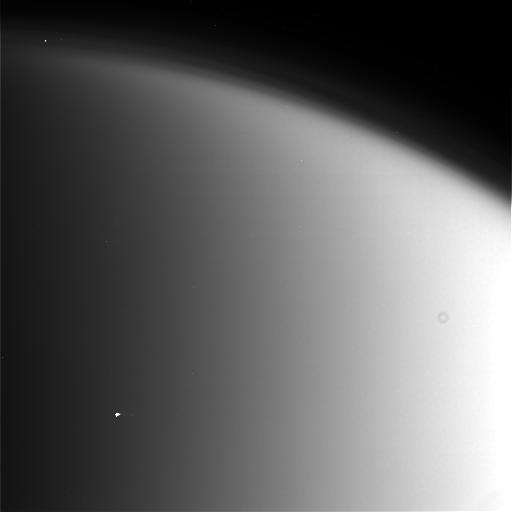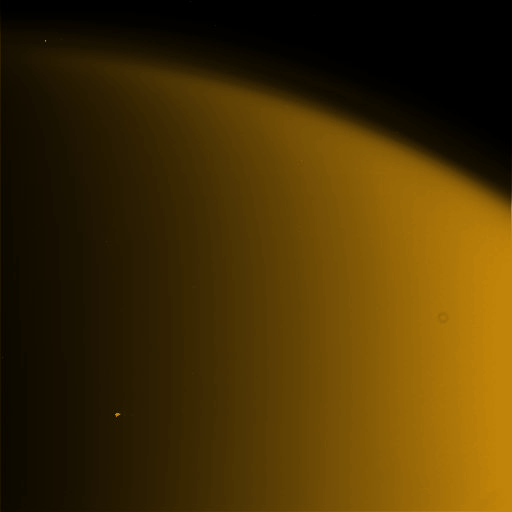February 26, 2020 : How Can We Explain The Attractiveness Of Titan In The Prospect Of The Dragonfly Mission ?
The engineers and scientists from NASA are preparing the Dragonfly mission to study Titan, a fascinating moon of Saturn. Why has Titan been a key target for planetologists ? The Cassini/Huygens mission which represents the latest mission to the Saturn System came to an end in 2017. During its long mission in the Saturn System which had started in 2004, we have had the opportunity to discover a fantastic world which looks like the Earth to a certain extent. There are lakes, seas, rivers, mountains, dunes, canyons, cloud systems or rainfall events on Titan like on Earth. Researchers believe that there is also a subsurface ocean dominated by liquid water beneath the presumed icy crust of the giant moon. That intriguing world was discovered by Christiaan Huygens in 1655 who called it « Luna Saturni ». Thanks to the 127 close flybys of the Opaque Moon and thanks to the data obtained from the Huygens probe during its extraordinary journey of January 14, 2005, we are starting to better understand Saturn's largest moon and new mysteries emerge. The Dragonfly mission may allow us to obtain key data regarding the landscape, the chemistry and the habitability of Titan.
Titan is a captivating world for many reasons. The giant moon is covered in a thick and opaque atmosphere which is clearly unique in the Solar System. Ganymede which is the largest moon in the Solar System is devoid of any atmosphere for instance. The presence of an atmosphere engenders a meteorology and erosional processes. The atmosphere is likely to fuel or accelerate chemical reactions. Titan's atmosphere is so dense and thick that the atmospheric pressure on its surface is higher than that of the Earth at sea level. Thus, the air is four times denser at the level of Titan's surface than our air at sea level. The opaque atmosphere of Titan, identified as soon as 1944 by the Dutch-American astronomer Gerard Kuiper, prevents us from discerning surface features from outer space. The Dragonfly drone will benefit from a particularly low gravity which is lower than the gravity of the Moon and from a relatively dense air which are likely to facilitate the flight of the probe. However, the drone will have to withstand the particularly low environmental temperatures representing around minus 290 degrees Fahrenheit, minus 179 degrees Celsius or 94 Kelvin. The Dragonfly drone may fly more than 100 miles or 160 kilometers during its mission which may last about 3 years.
Researchers often say that Titan's atmosphere looks like the atmosphere of the Early Earth. Titan's atmosphere is dominated by molecular nitrogen like our own atmosphere. Nitrogen represents, approximately, 95 percent of the composition of Titan's atmosphere which represents a higher concentration than that of nitrogen in the atmosphere of the Earth which is about 78 percent. However, oxygen which is the second most abundant gas of our atmosphere and which represents a concentration of about 21 percent is absent or almost absent in Titan's atmosphere. The second most abundant gas of Titan's atmosphere turns out to be methane. The haze of Saturn's largest moon is rich in hydrocarbons and organics. Some planetologists believe that the atmosphere of the Early Earth was relatively rich in methane without any significant concentration of oxygen. Microbes or microorganisms present in the ocean of the Early Earth may have generated the methane present in the atmosphere. A haze of organics or hydrocarbons resembling the atmosphere of Titan today may have existed on Earth 3.8 to 2.5 billion years ago.
The presumed opaque and orange atmosphere of the Early Earth may have allowed the development of life by acting as a shield against UV light from the Sun and by bringing key ingredients or nutrients to the primitive lifeforms. The atmosphere of Titan today may represent a natural prebiotic laboratory where complex chemical reactions involving complex organics, complex hydrocarbons or complex molecules are likely to take shape. The Dragonfly mission may allow us to gather precious clues regarding the chemistry of organics. We know that there are complex interactions between UV light from the Sun and molecules, particles or ions present in the upper atmosphere of the giant moon. Molecules like methane, ethane, propane, ethylene, acetylene or hydrogen cyanide can interact and engender new molecules or particles. In the orange haze of Titan, heavier molecules are likely to fall to the surface. The haze may generate complex organics or hydrocarbons. Can it produce amino acids, proteins, sugars or even more complex molecules ? Titan may contain the building blocks of the typical life we know.
Titan is rich in organics and hydrocarbons but the giant moon is devoid of any stable liquid water on the surface simply because the environmental temperature is too low. The environmental temperature of Titan at the level of the surface is low enough to allow the presence of liquid methane, liquid ethane or liquid propane on the surface. Can liquid methane or liquid ethane act as solvents on Titan like liquid water on Earth ? Can there be extremophiles on Titan ? We know that, on Earth, some microorganisms, like archaea or bacteria, can thrive in extreme environments like particularly dry environments, particularly warm environments, particularly cold environments or environments with a particularly high level of radiations. We don't know the mechanisms that have led to life on Earth but the exploration of Titan is likely to tell us a lot regarding the origin and the development of life. Experiments performed in the laboratory don't allow us to study the complex chemical reactions taking shape in the long run. That's why Titan may represent a major opportunity to know more about us. Lightning, solvents and key atoms or molecules like hydrogen, methane or carbon dioxide must have been involved in the formation process of life on Earth.
Planetologists often say that Titan may represent a prebiotic laboratory because it contains key ingredients of the typical life we know. As soon as the year 2034, the Dragonfly drone will start the exploration work of the Titanian environment from the land of dunes likely rich in organics or hydrocarbons to other locations like the Selk impact crater. Will it find exotic lifeforms, key organics or a prebiotic chemistry ? The geology of Titan may be varied like the geology of the Earth. The Dragonfly drone may visit several types of environments involving a different chemistry. There may be geysers or cryovolcanoes where one could find microorganisms or extremophiles like in the hot springs on Earth. Do the geysers spew water particles or methane molecules ? Are they related to pockets of liquid methane or liquid ethane ? Are they related to an internal ocean dominated by liquid water ? The external crust of Titan is likely rich in water ice. The Huygens probe had unveiled the presence of eroded stones or pebbles likely composed of water. The composition of Titan's soil may be quite different from the composition of the soil of Mars or the Earth. The surface of the other moons of Saturn is particularly rich in water ice. That's why we believe that the surface of Titan is also rich in water ice.
The Dragonfly drone may not visit lakes or seas because it will explore the equatorial region where linear and parallel dunes can be encountered. It is as if the drone explored the Sahara. The areas where the lakes, seas and rivers are found are located in the high latitudes of the moon or in the polar regions and the north polar region appears to be the most humid area today. We will have the opportunity to analyze the dynamics and the chemistry of the Titanian dunes which can be between 300 and 600 feet high or between 100 and 175 meters high. A parallel could be drawn between the dunes found in Namibia which can be 1000 feet high or 300 meters high and the dunes of Titan whose composition may be radically different from the composition of the dunes in Namibia. Some researchers imagine that the dunes of Titan resemble fine coffee because they may be composed of dark hydrocarbon molecules or molecules of frozen methane or ethane. By contrast, the dunes of the Earth can be rich in silicon dioxide or gypsum. On Titan, a significant contrast has been observed between the dark areas dominated by dunes and the bright areas which may be rich in water ice.
The environment can appear familiar to a certain extent because there is a methane cycle on that moon comparable to the water cycle of the Earth. In other words, there are evaporation processes, condensation processes and precipitation processes on Titan like on Earth. Clouds of methane or clouds of ethane have been regularly observed on Titan. In the area of the first extraterrestrial pool of stable liquids identified in the Solar System, in the south polar region of the giant moon of Saturn, transient and dynamic cloud systems had been clearly observed in the first half of the Cassini/Huygens mission in the Saturn System. The composition of the pools or rivers of Titan can vary geographically and seasonally. The lakes, seas or rivers may be dominated by a mixture of methane, ethane and dissolved nitrogen. Some pools of the Opaque Moon may look like some Terrestrial lakes like the Great Lakes in North America. Erosional processes can engender hills or valleys which could be compared to the hills or valleys in White Canyon, Utah and Guangxi in China. Studying Titan may be equivalent to studying our past to a certain extent.
- To get further information on that news, go to: https://solarsystem.nasa.gov/news/1184/why-is-nasa-sending-dragonfly-to-titan-here-are-five-reasons.

